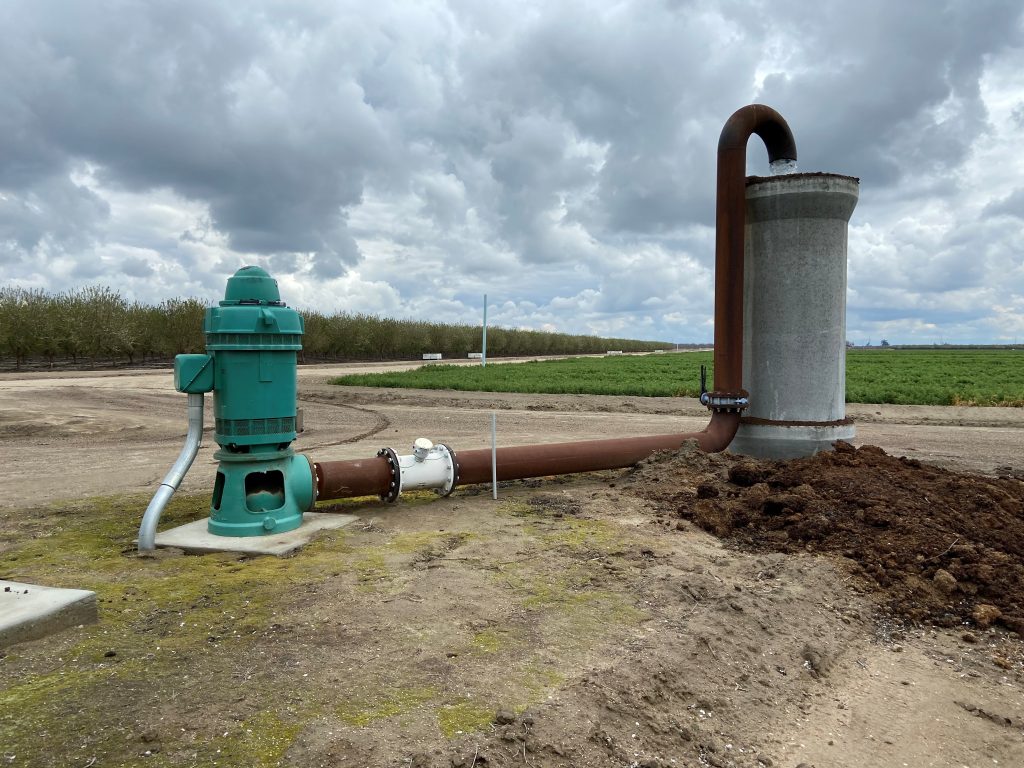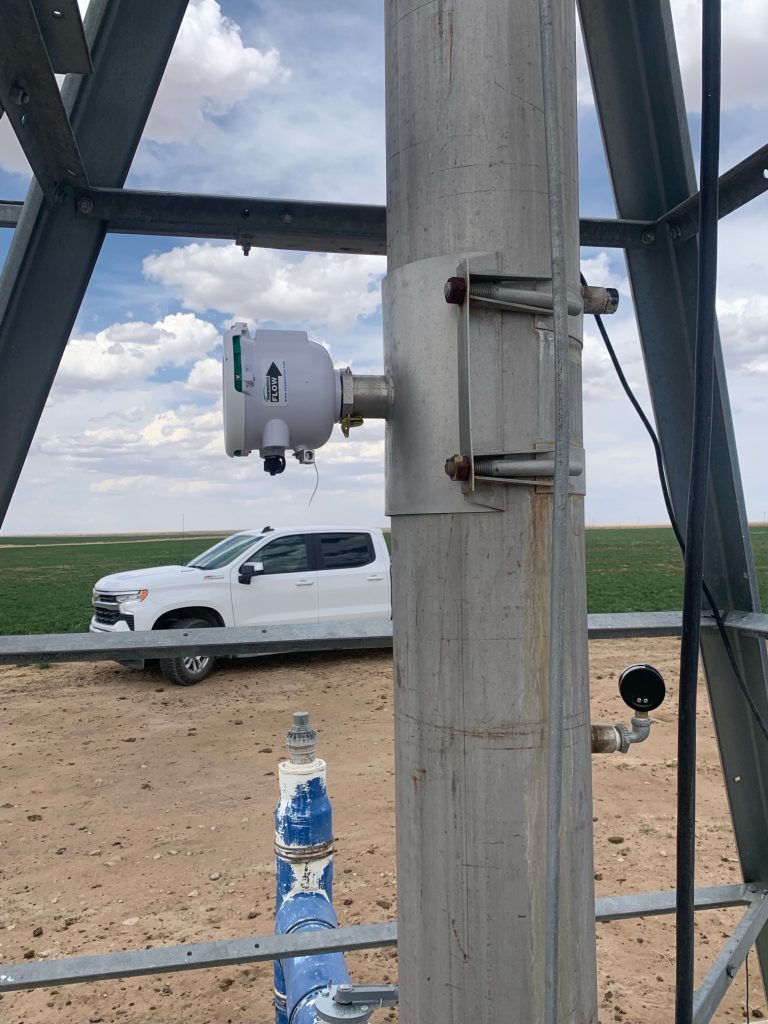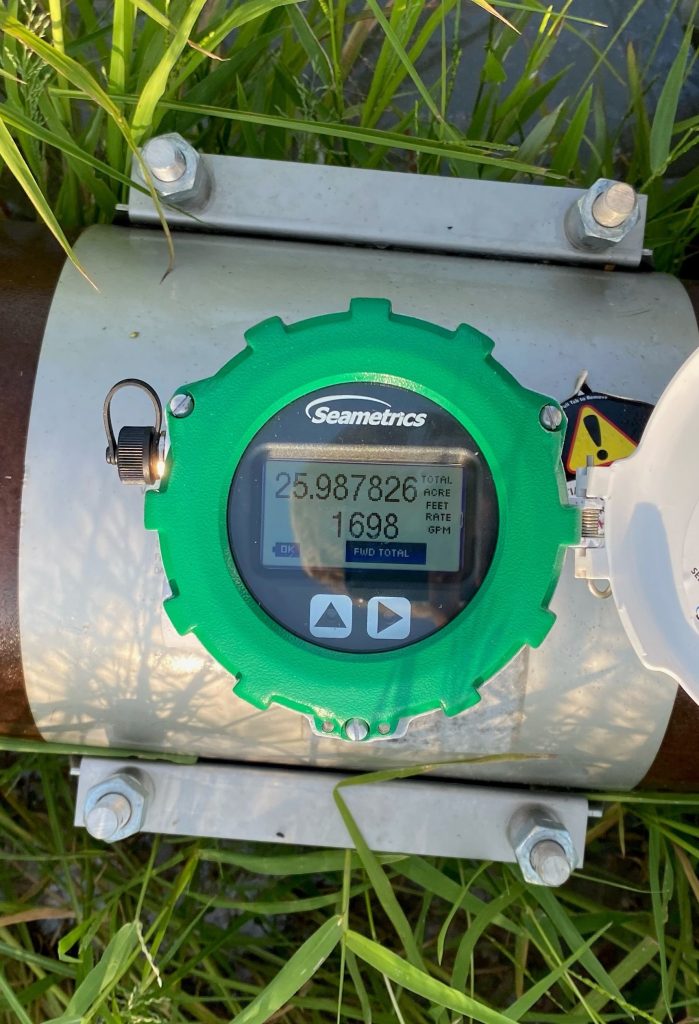By Katie M. Englin
Various methods are used to apply water to crops. Gravity irrigation systems use on-field
furrows or basins to move water across the field through gravity means only. Over the past
several decades, many irrigators have converted from gravity to pressurized irrigation systems.
Pressurized irrigation systems continue to gain popularity and apply water under pressure
through pipe or tubing to the crops and include: center pivot, drip, and sprinkler irrigating.
Today over 70% of irrigation systems in the U.S. are pressurized. In many field conditions,
pressurized irrigation systems are more water-use efficient than gravity systems, with less
water being lost to runoff and evaporation. No matter your method of irrigating, an efficient
irrigation system should include a working flow meter.

When the pump is on, water is moving and costs are being incurred. Many irrigation systems
use both electricity and fuel, making the cost of running the system very expensive. Flow
meters not only tell irrigators how much water they are using, they are also a valuable tool that
can be used to determine the health of an irrigation system and alert an irrigator if there is an
issue, leak, or power outage. Metering and monitoring an irrigation system can ensure
efficiency and prevent costly system damage and failures.
There are several types of flow meters available for irrigation today, with electromagnetic
meters now the most popular choice. Many electromagnetic flow meters are telemetry
compatible, enabling growers to monitor, be alerted to various flow anomalies, and in some
cases control the irrigation system via cell phone, iPad, laptop or desktop computer in real-time.

Reading a flow meter is much like reading the speedometer and odometer on a car.
A flow meter provides two valuable pieces of information:
1) The flow rate – This is the pumping rate and typically appears in gallons per minute
(GPM), though other units of measure are available. The flow rate is similar to a
speedometer on a car. The flow rate on a meter is showing the speed that water is
currently being pumped, while the rate on a car’s speedometer is telling how many
miles per hour the car is travelling. Knowing the volume of water being pumped per
time interval (think seconds, minutes, hours) tells you how much water you are getting
from your water source. This valuable piece of information is the actual pumping
capacity (GPM) and helps growers determine how many acres of irrigating their flow
rate will support. This information is valuable to keep record of on regular intervals. The
flow rate information can also be used to evaluate yearly or seasonal changes due to
water table drawdown, aquifer decline, pump wear and overall system health.
2) The flow totalizer – This is the total amount of water pumped and typically appears in
acre feet (AF) or gallons (GAL), though other units of measure are available. The flow
totalizer is similar to the odometer on a car. The flow totalizer shows the total amount
of water pumped through the meter. Most flow meter totalizers are non-resettable for
regulatory purposes, and continue to accumulate the total amount of water flowed
through the lifetime of the meter.

In addition to the main totalizer, some electromagnetic flow meters, such as the
Seametrics AG3000 and AG90 offer additional batching totalizer features that can be
used like the trip-o-meter on a car. These batching totalizers are resettable and can be
used to measure the total amount of water pumped between two points in time. If your
flow meter does not offer a batching totalizer, the seasonal water usage can still be
easily calculated by subtracting your beginning of season reading from your end of
season reading = season long amount of water volume pumped. The process of reading
a flow meter and calculating seasonal usage is further simplified if being read through a
telemetry system dashboard.
Ensure your flow meter is in good working order before the irrigation season begins. Just like
your truck or car, your flow meter will need occasional maintenance. While mechanical meters
have moving parts to wear out, electromagnetic flow meters have no moving parts making
them low maintenance and an overall lower cost of ownership. If your electromagnetic meter is
powered by a battery, you will want to keep record of the last time the battery was replaced,
and ensure the meter has a working battery before irrigation season begins. Many
electromagnetic flow meters for irrigation now offer up to a five year battery life. Refer to the
maintenance manual for your flow meter to understand expected battery life as indicated by
the manufacturer.
A flow meter is just one component of an entire irrigation system. The cost to purchase and
maintain a flow meter is a small fraction of the cost of an entire system, yet they provide
valuable information about water use and irrigation system efficiency enabling irrigators to
make smart decisions on managing their fields.
Smart Practices. Smart Technology.
Smart Business.
